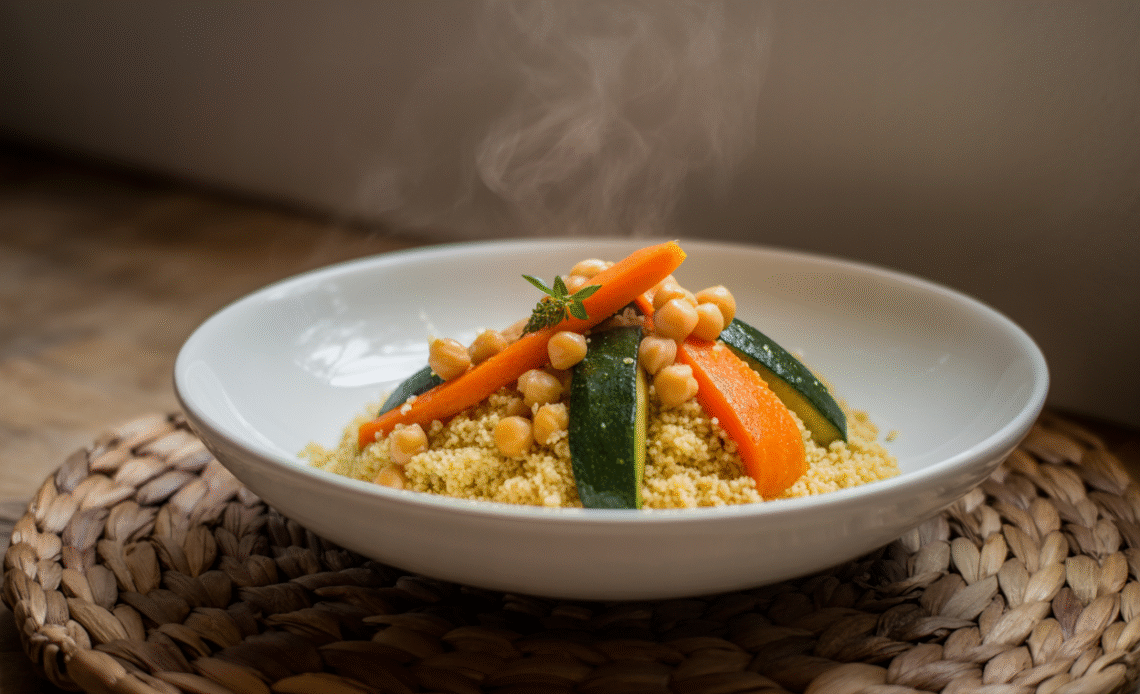
Quick Intro: Steam, Speed, and Staying Respectful
I grew up spooning boxed “couscous” next to Tuesday-night chicken, never guessing the real deal requires a dedicated couscoussière, three steamings, and the kind of communal patience that turns neighbors into family. Fast-forward: my Moroccan friend Aïcha invites me over, gently laughs at my instant grains, and schools me in traditional couscous fluffier than any five-minute miracle. Curiosity triggered, I ran a head-to-head test: authentic method vs. 10-minute hack. Want the verdict and a roadmap that honors North-African heritage without shaming busy cooks? Grab a fork, friend. 🙂
Table of Contents
- Understanding Couscous Culture (Why Respect Matters)
- Ingredient & Gear Checklist
- Method One: The Traditional Three-Steam Technique
- Method Two: The 10-Minute Stovetop “Hack”
- Head-to-Head Results Texture, Flavor, Nutrition, and Time
- Serving Ideas That Stay Culturally Aware
- Tips for Talking About Couscous (Avoiding Culinary Colonialism)
- FAQs & Troubleshooting Gummy Grains
- Wrap-Up Cheat Sheet
1. Understanding Couscous Culture (Why Respect Matters)
A Tiny Grain With Huge History
- Berber Origins: Evidence of hand-rolled semolina goes back to the 7th century Maghreb.
- Friday Ritual: In Morocco, Algeria, and Tunisia, couscous with seven vegetables anchors weekly family gatherings after Friday prayers.
- UNESCO-Listed: “Knowledge, know-how and practices pertaining to the production and consumption of couscous” earned Intangible Cultural Heritage status in 2020.
Cultural Respect Checklist
- Call it what it is. Couscous ≠ quinoa, polenta, or “cauliflower rice.”
- Credit the source. Reference North-African communities in recipes and posts.
- Pronounce it right. It’s koos-koos, not cuz-cuz (Aïcha insists).
- Value time as seasoning. Extra steps aren’t fuss they’re flavor and memory.
2. Ingredient & Gear Checklist
| Item | Traditional | 10-Min Hack | Why It Matters |
| Medium-grain semolina | 500 g | 500 g instant couscous | Authentic uses raw semolina rolled with salt & water. |
| Olive oil or smen | 3 Tbsp | 2 Tbsp | Adds aroma; prevents clumps. |
| Salted water or light broth | 2–3 cups | 2 cups boiling water | Hydrates grains. |
| Couscoussière | ✔ | ✖ | Two-tier pot for steam; hack uses plain pot + lid. |
| Large gsaa (wide bowl) | ✔ | ✖ | For rolling between steamings. |
| Fork | ✔ | ✔ | Fluffing hero. |
FYI: You can mimic a couscoussière with a Dutch oven + metal sieve, but gaps = soggy fail.
3. Method One: The Traditional Three-Steam Technique
Time: 1 hr 40 min active-ish
Yield: 6 cups cloud-soft couscous
Step-by-Step
- Damp & Salt
- Place semolina in gsaa. Spray with ½ cup lightly salted water while tossing with fingers. Grains should feel like beach sand after a wave: damp but separate.
- Place semolina in gsaa. Spray with ½ cup lightly salted water while tossing with fingers. Grains should feel like beach sand after a wave: damp but separate.
- Steam #1 (15 min)
- Transfer to steamer basket. Keep holes unclogged. Steam over simmering vegetable broth until a slight wheat aroma escapes.
- Transfer to steamer basket. Keep holes unclogged. Steam over simmering vegetable broth until a slight wheat aroma escapes.
- Roll & Oil
- Dump back into gsaa. Sprinkle 1 Tbsp olive oil. Use palms to roll and break lumps. Add another ¼ cup water to re-dehydrate grains evenly.
- Dump back into gsaa. Sprinkle 1 Tbsp olive oil. Use palms to roll and break lumps. Add another ¼ cup water to re-dehydrate grains evenly.
- Steam #2 (15 min)
- Return to pot; steam again. Grains swell significantly.
- Return to pot; steam again. Grains swell significantly.
- Roll Again
- This time, no extra oil, just separate. Add pinch salt water if dryness lurks.
- This time, no extra oil, just separate. Add pinch salt water if dryness lurks.
- Steam #3 (10–15 min)
- Final puffing. Taste a grain: tender, no raw grit.
- Final puffing. Taste a grain: tender, no raw grit.
- Final Fluff
- Toss with butter or smen. Ready for seven-veg stew, raisins, or milk for breakfast.
- Toss with butter or smen. Ready for seven-veg stew, raisins, or milk for breakfast.
Why the fuss? Each steam/roll cycle builds aerated layers so sauce can travel between grains instead of pooling.
4. Method Two: The 10-Minute Stovetop “Hack”
Time: 10 minutes flat
Yield: 6 cups decent-but-different couscous
Quick Directions
- Bring 2 cups salted water + 2 Tbsp olive oil to rolling boil.
- Kill heat; dump in 500 g instant couscous. Stir once.
- Cover 5 min.
- Fluff with fork, splash ¼ cup warm water if clumpy. Serve.
What’s “instant”? Pre-steamed and dried semolina granules; saves you steps but also “personality.”
5. Head-to-Head Results Texture, Flavor, Nutrition, & Time
| Metric | Traditional | 10-Min Hack | Winner |
| Texture | Feather-light, separate, slight chew | Softer, occasionally gummy | Traditional |
| Flavor | Nutty wheat aroma amplified by steam | Mild, almost neutral | Traditional |
| Sauce Absorption | Grains stay intact, soak broth evenly | Grains collapse, form paste pockets | Traditional |
| Glycemic Index | 63 (estimated) | 65 (little higher) | Tie |
| Active Labor | 25 min hands-on | 2 min hands-on | Hack |
| Equipment Need | Specialized pot | Any saucepan | Hack |
Taste-Test Panel (Aïcha + two teen cousins + me)
- “Feels like eating clouds.” Traditional vote x3
- “Fast one is okay for school lunch boxes.” 1 hack defender
Bottom line: For celebrations, honor tradition. Weeknight meal? The hack passes, if you respect flavor add-ins (see Section 6).
6. Serving Ideas That Stay Culturally Aware
Respectful Pairings
- Seven-Vegetable Tagine (carrot, zucchini, pumpkin, cabbage, turnip, chickpea, tomato).
- Tfaya caramelized onion, raisin, and cinnamon topping.
- Harissa & preserved-lemon chicken.
Flavor Boosts for Instant Couscous
| Add-In | Quantity | Hack Benefit |
| Toasted slivered almonds | ¼ cup | Crunch distracts from soft texture. |
| Finely grated raw carrot | ½ cup | Color & moisture. |
| Ras el hanout butter | 2 Tbsp | Authentic aroma waft hack upward. |
Avoid calling your bowl “couscous salad” if it’s mostly quinoa + feta. Different grain, different culture.
7. Tips for Talking About Couscous (Avoiding Culinary Colonialism)
- Say “inspired by” rather than “authentic” if you skipped traditional steps.
- Credit recipe mentors: “Adapted from my friend Aïcha’s family method.”
- Reference geography (Maghreb, Amazigh heritage) rather than generic “Middle Eastern.”
- Share room for adaptation dietary needs happen but keep core elements recognizable.
Ever seen a recipe label couscous as “Moroccan pasta”? Yeah… Don’t. 😬
8. FAQs & Troubleshooting Gummy Grains
Q1. My grains clump like oatmeal during steaming why?
A: Too much water in dampening phase or holes blocked with grains. Use spray bottle; shake sieve mid-steam.
Q2. Instant couscous tastes bland.
A: Toast dry grains in 1 Tbsp butter 2 minutes before adding boiling water; nutty upgrade.
Q3. Can I use whole-wheat couscous in traditional method?
A: Yes, but extend each steam 5 minutes bran slows hydration.
Q4. How to reheat leftovers?
Traditional: Steam 5 minutes. Instant: Mist with water, microwave 1 minute, fluff.
9. Wrap-Up Cheat Sheet
- Three-steam method = gold standard for weddings, holidays, food pride.
- 10-minute hack = weeknight saver but amplify flavor to avoid flatness.
- Respect culture: name origins, pronounce right, avoid “pasta” shortcuts.
- Texture rules: damp but not soggy, steam vents clear, roll between palms.
- Fluff often, serve hot, and if possible eat with family from a single communal platter. ❤️
Now excuse me, leftover couscous + poached eggs await, and they’re not sharing. 😋



